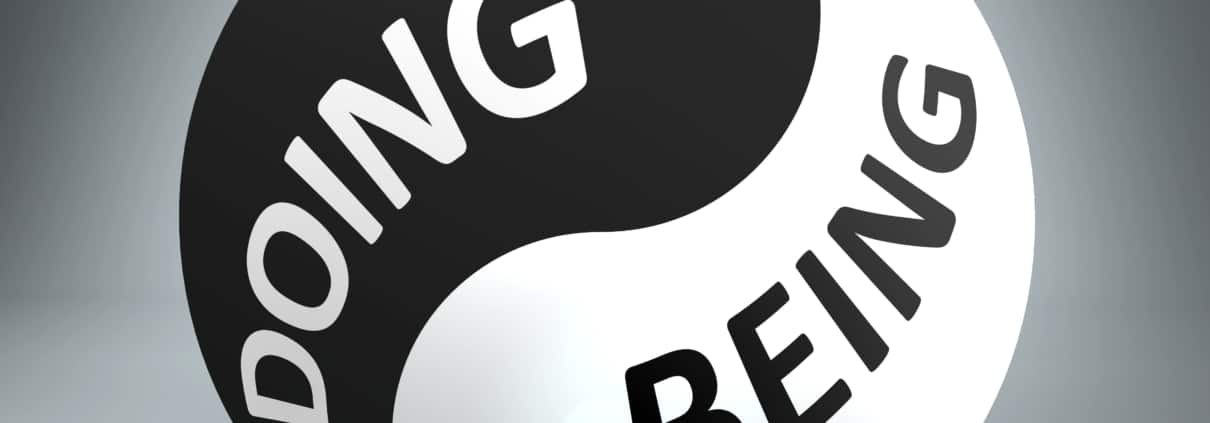A Real “Chicken and Egg” Conundrum
This week we’ll be looking at an idea that has been turning around and around in my head for a long time, and it’s now high time for me to try to deal with it here.
At first I had planned to title this post “The Doing / Being Circle” because to me these two interconnected concepts feel like a wheel that just keeps rolling along, with each one taking a turn at being on top.
And then of course my opening sentence, which was spontaneously written as opposed to planned, used the phrase “turning around and around”.
So, please sit down to read the rest of this, because dizziness may ensue. You’ve been warned.
Sparked by a Quote from a Book
I consume books in various ways, from hard copies to the many audiobooks I enjoy on my long drives to and from our cottage, to the ones I read on my Kindle while pedaling my exercise bike.
When I see something I want to refer back to on Kindle, I typically take a photo of the page with my phone.
Yes, I’m aware that there’s a way to annotate Kindle books and probably even export quotes, but my kids have used the phrase “OK Boomer” with me, so I’m just glad to be able to do it, my way.
The book was Adam Grant’s Give and Take and here’s the quote:
“To paraphrase the writer E.M. Forster,
‘How do I know who I am until I see what I do?’”.
Let’s just say that reading that brought this idea to the front burner of my mind pretty quickly.
Don’t You Have to BE, Before You Can DO?
I guess the factory setting in my brain worked the other way from Forster’s, because I used to think that you had to be someone or something before you could do anything.
Now I’m not sure what to think.
Actually, what I’m not sure of is whether either one of these really does “come first”, just like the old “chicken and egg” quandary.
As I consider how this whole subject fits into my work with families who own and manage assets together, it has me harken back a few weeks to My “Role / Goal / Control” Life Hack.
There, the first step was to determine what role one is playing in a given situation, so that’s all about the being, and figuring out who you need to be for that role.
What you then need to do will flow from that.
But does it always work that way?
And What About “Modus Operandi” vs “Modus Vivendi”?
Almost a year ago now, in Family Governance, More Than a Modus Operandi, we looked at this very same question.
Here’s a direct, cut’n’paste quote:
I feel like I’ve been over this territory a lot, but it’s so
important that it bears repeating nonetheless.
This “territory” is the distinction
between “doing” and “being”.
Because “Modus Operandi” is about doing, it refers to how family members “co-operate” together.
Modus Vivendi, for its part is more about how family members “co-exist” and “co-habitate” together.
But of course these are all inter-related and cannot and do not exist in isolation from each other.
We can, however, benefit from thinking about each separately.
Interdependence Strikes Again
Like so many aspects of this work with people, interdependence strikes again. Not just with the fact that the people are interdependent, but the concepts that we need to work on with them are as well.
What you do, over and over, becomes part of who you are. And, it follows, who you are will necessarily influence how you do all the things that you do.
When you run into a tricky situation with one, you may want to look at it from the other side, to see what you might learn about how to deal with it.
Like the “family alignment / family engagement” issue we talked about in Family Engagement and Family Alignment – Chicken and Egg when you run into something from one, you can look to the other for a next step towards enlightenment and resolution.
Questions, More Important Than Answers, As Usual
I also like that this is yet another illustration of the fact that knowing the right questions is more important than having all of the answers.
When you work with members of a family on their relationships, it’s mostly about getting them to communicate in productive ways, so that the “right answers” for their particular situation will emerge, and that they end up co-creating their own solutions.
They’ll do what they’re going to do and be who they’re going to be, and we just need to guide them.




